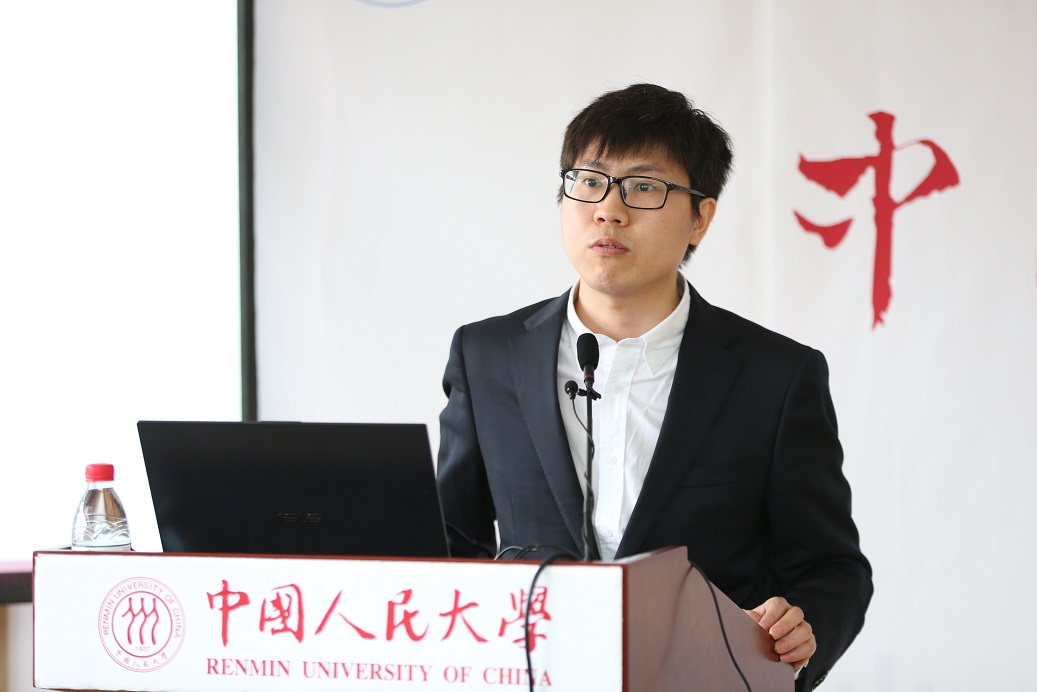 Research Update
Research Update
27
AprOn April 19, 2018, the Monthly Conference on Macroeconomic Data Analysis of China’s Macroeconomic Forum was held in the Renmin University of China (RUC) by National Academy of Development and Strategy (NADS) and School of Economics of RUC, and China Credit Management Co., Ltd. At this conference, macroeconomic data of the first quarter of 2018 were analyzed and interpreted.

Executive Vice Director Liu Fengliang of the Graduate School, RUC presided over the conference.
Attendees of the conference included Yan Yan, President of China Cheng Xin International Credit Rating Co., Ltd. and Joint Vice Director of the Institute of Economic Research (IER) of RUC; Zhang Ming, Dean of the Research Division of International Investment of the Institute of World Economics and Politics (IWEP) of Chinese Academy of Social Sciences (CASS); Zhong Zhengsheng, Managing Director of Caixin Insight; Xiao Lisheng, Vide Dean of the Research Division of International Finance of IWEP; Li Chengjian, Associate Research Fellow of the Department of Macroeconomic Research of Development Research Center (DRC) of the State Council; and Liu Fengliang, Executive Vice Director of the Graduate School of RUC.

Research Fellow Liu Xiaoguang of NADS released, on behalf of the Research Group, the monthly report on macroeconomic data analysis. According to the report, China’s economy developed steadily in the first quarter of 2018, with six highlights. First, the actual GDP growth was relatively steady, and got rid of the rapid downturn; second, endogenous power of investment improved, and policy factors fell down; third, price signals were steady, and the four gaps were reduced; fourth, microscopic foundation was solid, and operating status of middle and small-sized enterprises improved; fifth, macroscopic prosperity was sustained, and market players became confident again; last, economic structure was optimized continuously and steadily towards high-quality development.
2018 started towards good prospects on the whole with hidden worries, and short-term macroeconomic trend is uncertain in four aspects. First, warning signals have emerged recently in industry, though it has broken away from depression; second, investment has tended to be stable on the whole, but the low-level polarization persists; third, external demand registers negative contribution, instead of positive contribution, to economic growth; fourth, in-depth structural problems hide behind the continuous downturn of consumption. The above-mentioned four factors will affect short-term economic trends from supply and demand, and part of the effect has been manifested in data of March. The development trend is worthy of high attention though some signals are weak.
Across 2018, China’s macro economy will be under the downward pressure of “double restraints”. One is internal restraint, under which monetary financing is tightly balanced and financial policies are hard to work. Under the background of “structural deleverage”, financial policies and monetary policies in broad sense may form a “double-pressing” situation that will incur downward pressure against China’s economic trend. The other one is external restraint, under which external financial impact may increase because it’s hard to improve external demand in the early stage. On the one hand, the world’s economic recovery is weaker, trade friction is aggravated and external demand declines; on the other hand, asset bubbles spread across the world and financial risks increase.
Based on said analysis, we deem the economic trend tends to good prospects with hidden worries, and bear pressure in a short term under double restraints. Therefore, we have put forward six policy suggestions. First, according to the macroeconomic situation of the first quarter of 2018, we should recognize in a scientific manner the macro economy of 2017 that was more stable than expected, and China hasn’t opened the new cycle and it’s not time for the overall withdrawal of the expansionary macroeconomic policy. Second, the core of the stable growth in 2018 remains in steady investment, but policy directions and instruments should be adjusted greatly. So, it’s advisable that systematic schemes for launching private investment in 2018 be issued so as to adjust the investment expectation in all aspects. Third, in the process of financial reorganization and deepening of financial system reform, China’s monetary policy of 2018 should be positioned as same as 2017, but the operation may be appropriately loose; interest rate level shouldn’t increase too rapidly in a short term, and cheap monetary policy should remain an important foundation for the recovery of private investment. Fourth, the supply-side structural reform should be further deepened and expanded and then, enhanced in “reducing cost” and “improving weak links”. Fifth, government administration restructuring should shift from investment-oriented government to people’s livelihood-oriented government. It must be seen explicitly that we must jump out of the past paradigm in order to deepen the reform in all aspects in the new era. Efforts should be exerted in government system reform and social reform so as to lay an authoritative foundation, administrative implementation foundation and social foundation for the reform of the economic system. Sixth, high attention should be paid to the changes in global economic situation and trade pattern. We should continue to expand the opening-up, cope with trade friction proactively, and make more efforts to prevent the impact of global financial risks.
Attendees had in-depth discussions and evaluations of the macroeconomic data and analysis report of the first quarter, and presented their brilliant viewpoints and pertinent policy suggestions.